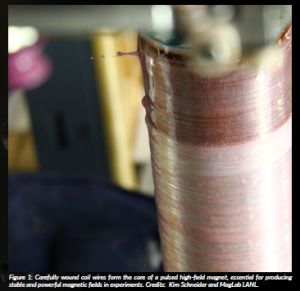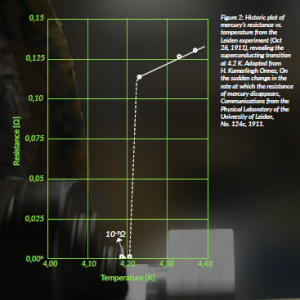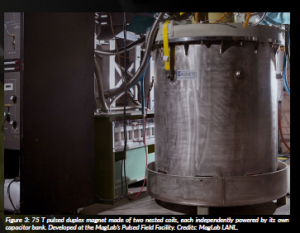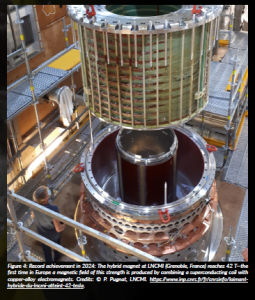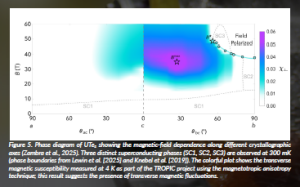Kimberly Modic & Valeska Zambra
In 1911, Kammerlingh Onnes discovered superconductivity by accident. He probably would have never imagined that more than 100 years later, superconductivity remains one of the most mysterious topics in physics, with many questions still looming.
Superconductivity
After liquefying helium, Onnes wanted to study the resistance of different materials at low temperatures. Unexpectedly, he found that the resistance in mercury completely vanished at a temperature of 4.2 K—just a few kelvin above absolute zero. After much repetition, he convinced himself that the phenomenon was real and called it the ‘disappearance of resistance’, later known as superconductivity. After cooling down different metals, he found superconductivity to be prevalent. Today, we know that about 30% of elements become superconducting under the right conditions. The most exciting aspect about superconductors is that current can flow through them unimpeded and indefinitely—without the usual resistive losses found in normal metals—and that has huge technological potential. One example is the creation of the strong magnetic fields needed for hospital magnetic resonance imaging (MRI) machines. Strong magnets can be made with coils of superconducting wire. The superconductor allows current to pass through the coil, generating the magnetic field, literally forever, without a connection to a power supply! The only caveat is that the coil must be cooled below the ‘critical temperature’, known as Tc, where the metal transforms into a superconductor.
Resistive magnets
In the late 1950s, before superconducting coils, magnets were formed from coils made out of normal, resistive metals, such as copper. A large amount of continuous current (on the order of 1–5 kA) is driven through the coil, generating a magnetic field along its centre. The main problem was heat dissipation caused by electrical resistance. Even with a water-cooling system to counteract heating, the maximum achievable magnetic field with a resistive coil was limited to about 10 tesla at that time.
Mechanism of conventional superconductors
A natural way to resolve the heating of resistive coils (and produce bigger magnets) is to replace the copper wire with superconducting wire. Despite the best minds working on the problem, including Einstein and Heisenberg, superconductivity was not understood during Onnes’ lifetime; however, one lifetime is often not enough to complete the arc of scientific discovery. It was nearly half a century after his discovery when Bardeen, Cooper and Schrieffer (BCS) developed a theory to describe the microscopic mechanism behind superconductivity. Below a critical temperature, lattice vibrations of the material (phonons) mediate an attractive interaction between electrons that would otherwise repel one another. This allows the electrons to form so-called Cooper pairs that move effortlessly through the material, without resistance. BCS provided a mechanism for superconductors with low Tcs ranging from 10–30 K. But that’s only the first, ‘conventional’ half of the story! After all, we’re still searching for a superconductor that works at room temperature (300 K) today.
Magnetic fields and superconductors
In the 1960s, armed with BCS theory, the scientific community began searching for new superconducting materials that could support higher magnetic fields. One breakthrough was the discovery of niobium-titanium (NbTi), which supports fields up to 15 tesla—a huge field compared to Earth’s 0.00005 tesla or the 1 tesla needed to lift a car. NbTi has an additional key advantage: it is ductile, unlike earlier brittle superconductors. This property allows wires to be bent without cracking, enabling the fabrication of superconducting coils for powerful magnets. The Tc of NbTi is ~9 K; it requires liquid helium cooling. Despite the cost, NbTi coils revolutionised medical imaging and improved millions of lives. MRI development and other technologies continue alongside advances in understanding superconductors and their response to magnetic fields. The biggest limitation for superconducting magnets was not their need to be cooled to cryogenic temperatures, but rather the ‘critical magnetic field’ that the superconductor could withstand before returning to a normal metal. Modern superconducting magnets made from conventional superconductors can reach impressive fields of about 23 tesla.
Pulsed magnetic fields
Higher magnetic fields are desired to discover and explore new phenomena in materials and, in particular, to help in the search for higher-Tc superconductors. Since superconducting magnets were limited in field strength, resistive coils were reconsidered along with the idea to apply a large amount of current over a short time interval to prevent the coil from overheating. By reducing the diameter of the coil, the heating can be further reduced, and the magnetic field inside the coil can be enhanced, leading to the era of ‘pulsed’ magnetic fields. The procedure for generating the pulsed magnetic field consists of storing a large amount of electrical energy in a capacitor bank—typically on the order of a megajoule—and discharging a sudden pulse of current into a resistive coil that produces magnetic fields up to 60 tesla, or even 100 tesla when the science really calls for it! The entire duration of a pulse (from 0 to 60 tesla and back to 0) lasts roughly 1/10th of a second, creating a challenging environment for the experiment taking place inside. The measurement setup is constrained to a small workspace within the bore of the magnet—typically a few millimetres. Other difficulties include temperature stability, extreme mechanical and electrical vibrations due to the abrupt discharge of energy and the requirement that measurement signals must be much faster than the pulse itself, on the order of microseconds.
The first pulsed magnets were developed in the 1950s and were able to reach roughly 20 T. However, they faced a major problem: the intense internal forces generated by the magnetic field often destroyed the coils—the whole setup typically survived only a single pulse. Building a new magnet coil for every measurement was prohibitively inefficient. It wasn’t until the early 1980s, driven by the need to study new materials under higher magnetic fields, that major headway into the development of reusable, non-destructive coils began. Advancements in materials for coil construction, insulation and structural reinforcement enabled the design of coils capable of withstanding the intense mechanical stresses and heating associated with pulsed operation. Today, some of the most well-known pulsed magnetic field facilities are: NHMFL (USA), LNCMI (France), HLD (Germany) and IMGSL (Japan). The primary obstacle to generating pulsed magnetic fields exceeding 100 tesla remains the mechanical strength of the materials used to construct the coil and its reinforcements, which must withstand the extreme forces associated with such high magnetic fields.
High-Tc
For decades, scientists have been searching for a ‘super material’—theorising, synthesising new compounds and testing them under extreme conditions—hoping to find any sign of high-Tc superconductivity. In 1986, a major breakthrough occurred: the birth of high-Tc superconductors. These copper-oxide (cuprate) compounds quickly captured attention, and by the following year, some had already reached critical temperatures up to 92 K. Years later, cuprates were found with even higher Tc values, reaching up to 135 K. While this is still much colder than room temperature (around 300 kelvin), the surprise was that, based on everything we knew about BCS superconductivity, a Tc of 135K seemed impossible. It was a major milestone because superconductors now exist above the boiling point of liquid nitrogen (77 K ), and liquid nitrogen is much cheaper and easier to handle compared to liquid helium.
However, these high-Tc superconducting compounds are ceramics! They are brittle and difficult to fabricate into long, flexible wires, with high production costs. Even so, high-Tc superconductors are currently used in experimental power cables and are being explored for quantum computing components and levitating trains.
Room-temperature superconductivity
The discovery of superconductivity transformed the 20th century, advancing our fundamental understanding of quantum mechanics and leading to the development of magnets for experimental physics and medicine. However, the dream of having a room-temperature superconductor remains unfulfilled. The idea of current flowing without energy losses could translate into having electricity in our homes with greatly reduced energy costs. This sounds like utopia, but to implement it, we cannot rely on superconducting wires with such low Tcs, as they would require expensive cooling systems. Instead, we need to find a material capable of superconducting at room temperature. The discovery of such a material would represent a true breakthrough—one that redefines physics, transforms industry and everyday life—and surely deserves a Nobel Prize. Because of its huge potential impact, many false claims of room-temperature superconductivity have appeared over the years. In the past decade, several high-profile retractions from top scientific journals have addressed these claims. Fortunately, the scientific community corrected these errors, emphasising the need for overwhelming evidence when the stakes are high.
The search is incessant. In the 2010s, extreme pressures applied to metallic ‘superhydrides’ (compounds containing lanthanum and hydrogen) demonstrated Tcs up to 260 K, which is close to room temperature. The main problem is that superconductivity in these materials requires enormous pressures of around 200 GPa, comparable to those in Earth’s outer core, which is clearly far from practical use.
To achieve the ultimate goal of finding a room-temperature superconductor, scientists have spent nearly four decades studying these materials, exploring their properties by cooling, applying pressure, altering their chemical composition and using high magnetic fields, among other methods. Our desire to understand high-Tc superconductors has driven the development of nearly every major experimental tool in condensed matter physics, but we still don’t have an explanation for their incredibly high Tcs.
Our work pertaining to unconventional superconductors
The search for high-Tc superconductors has raised fundamental questions, revealing that their superconductivity isn’t phonon-mediated, unlike in BCS theory. This is why we call high-Tc superconductors ‘unconventional superconductors’, they cannot be described by BCS theory. It is now believed that unconventional superconductors are mediated by ‘magnetic fluctuations’, the dynamic movement of the electron’s magnetic moment, or ‘spin’, that is not totally random.
In 2019, an exceptional, unconventional superconductor emerged: UTe2. This material exhibits many different superconducting phases under different conditions. The most extraordinary superconducting phase occurs at extremely high fields of 40-70 tesla. This behaviour is opposite to that expected when magnetic fields are applied to a conventional superconductor—usually, the superconducting state is destroyed. The high-field superconductivity in UTe2 has sparked great interest in trying to understand its underlying mechanism. If the high-field superconductivity in UTe2 is indeed driven by magnetic fluctuations, then scientists might expect to see magnetic order nearby— the typical consequence of fluctuating moments. Recent studies have not been able to show evidence for magnetic order at high fields. We recently measured UTe2 in magnetic fields of up to 60 tesla using a newly developed method that is uniquely sensitive to magnetic fluctuations and confirmed that they indeed exist near its magnetic-field-reinforced superconducting phase. While we are still far from forming a complete understanding of the exotic superconductivity in UTe2, our work strongly suggests that a previously predicted mechanism—magnetic fluctuations—used to explain unconventional superconductors may also hold in this case. This moves us one step further in our quest towards understanding unconventional, high-temperature superconductors.
References
Knebel, G., Knafo, W., Pourret, A., Niu, Q., Vališka, M., Braithwaite, D., Lapertot, G., Nardone, M., Zitouni, A., Mishra, S., Sheikin, I., Seyfarth, G., Brison, J.-P., Aoki, D. and Flouquet, J. (2019) ‘Field-reentrant superconductivity close to a metamagnetic transition in the heavy-fermion superconductor UTe₂’, arXiv preprint, arXiv: 1905.05181.
Lewin, S.K., Czajka, P., Frank, C.E., Saucedo Salas, G., Noe II, G.T., Yoon, H., Eo, Y.S., Paglione, J., Nevidomskyy, A.H., Singleton, J. and Butch, N.P. (2025) ‘High-field superconducting halo in UTe₂’, Science (New York, N.Y.), 389(6759), pp. 512–515. doi: 10.1126/science.adn7673.
Zambra, V., Nathwani, A., Nauman, M., Lewin, S.K., Frank, C.E., Butch, N.P., Shekhter, A., Ramshaw, B.J. and Modic, K.A. (2025) ‘Giant transverse magnetic fluctuations at the edge of re-entrant superconductivity in UTe₂’, arXiv preprint, arXiv: 2506.08984.
Project summary
UTe2 was recently discovered as an unconventional superconductor, featuring multiple superconducting phases including one that persists up to 70 tesla. By performing sensitive measurements of the magnetic anisotropy at very high magnetic fields, we study the interplay between its magnetism and high-field superconductivity. Our results suggest that transverse magnetic fluctuations are responsible for mediating high-field superconductivity in UTe2.
Project partners
UTe2 samples were synthesised and provided by Nicholas Butch (Assistant Professor, University of Maryland), Sylvia K. Lewin (Postdoc, University of Maryland and NIST Center), and Corey E. Frank (Assistant Professor, New Mexico State University). Measurements were performed at the National High Magnetic Field Laboratory with contributions from Arkady Shekhter (NHMFL Los Alamos) and Brad Ramshaw (Associate Professor, Cornell University).
Project lead profile
Kimberly Modic earned her PhD in Physics from the University of Texas at Austin, with research at the National High Magnetic Field Laboratory. She developed the magnetotropic anisotropy technique, a key method in the study of anisotropic quantum materials. After a postdoc at the Max Planck Institute in Dresden, she became an Assistant Professor at ISTA in 2020, leading the Thermodynamics of Quantum Materials at the Microscale group.
Project contacts
Kimberly Modic
Kimberly.Modic@ist.ac.at tqm.ista.ac.at @atthemicroscale
Funding disclaimer
This project has been funded by the European Research Council (ERC) under the European Union’s Horizon Europe research and innovation programme – grant agreement number 101078696.
Views and opinions expressed are however those of the author(s) only and do not necessarily reflect those of the European Union or the ERC. Neither the European Union nor the granting authorities can be held responsible for them.
Figure legends
Figure 1: Carefully wound coil wires form the core of a pulsed high-field magnet, essential for producing stable and powerful magnetic fields in experiments. Credits: Kim Schneider and MagLab LANL.
Figure 2: Historic plot of mercury’s resistance vs. temperature from the Leiden experiment (Oct 26, 1911), revealing the superconducting transition at 4.2 K. Adapted from H. Kamerlingh Onnes, On the sudden change in the rate at which the resistance of mercury disappears, Communications from the Physical Laboratory of the University of Leiden, No. 124c, 1911.
Figure 3: 75 T pulsed duplex magnet made of two nested coils, each independently powered by its own capacitor bank. Developed at the MagLab’s Pulsed Field Facility. Credits: MagLab LANL.
Figure 4: Record achievement in 2024: The hybrid magnet at LNCMI (Grenoble, France) reaches 42 T—the first time in Europe a magnetic field of this strength is produced by combining a superconducting coil with copper-alloy electromagnets. Credits: © P. Pugnat, LNCMI. https://www.inp.cnrs.fr/fr/cnrsinfo/laimant-hybride-du-lncmi-atteint-42-tesla.
Figure 5: Phase diagram of UTe₂ showing the magnetic-field dependence along different crystallographic axes (Zambra et al., 2025). Three distinct superconducting phases (SC1, SC2, SC3) are observed at 300 mK (phase boundaries from Lewin et al. [2025] and Knebel et al. [2019]). The colourful plot shows the transverse magnetic susceptibility measured at 4 K as part of the TROPIC project using the magnetotropic anisotropy technique; this result suggests the presence of transverse magnetic fluctuations.


